Extrude & Weave
Extrude & Weave Lesson for members of the Vectric Master Training Course:
Vectric Documentation:
Extrude and Weave

The Extrude and Weave feature is a very powerful and flexible modeling tool. It uses one or more vector drive-rails to define the path that the shape will follow, this allows you to extrude either vector cross-sections or 3D Components along these vectors to create the model.
The first stage is to select the drive rails and then choose whether you want to use either vectors or Components to extrude along your curves. There are many options both on the form and under the context sensitive right-click menus that can be used to control the shape that is created.
Drive Rail Selection
From the 2D View use the mouse to select one or more open or closed vectors you wish to use as the drive rails for you to extrude or weave along. Then click the Use Selection button.
In the 2D view your rail vectors will be highlighted orange and now show a green square (start node) indicating the start of the vector from which the extruded shape will begin, and arrow markers along its length to show the direction of the extrusion.

The default start point and direction shown may not be what you intended. To change the direction, right-click with the cursor on the vector line and select Reverse Rail from the context sensitive menu, you will now see the arrows on the drive rail change direction. On a closed vector you can change the start point by placing the cursor over an existing node in the drive-rail vector, right-clicking and selecting Make Start Point or you can right-click anywhere on the vector and select Insert Start Point to create a new node which will become the start point.
Note
Remember that you can hold down a Shift key while left-clicking on vectors in the 2D view to include more than one vector in the selection.
The Clear Rails button can be used at any time to empty your current selection. This will delete your current shape and deselect all the drive rail and cross section vectors. This can be used if you do not want to create a Component before you exit the form or if you want to select new vectors in the 2D view to use as the drive rail for your shape.
Using Vector Cross Sections
In this section of the form you can select whether to use vector cross sections or Components to extrude along your drive rails, select either Use Vector Cross Sections or Use a Component to make your choice.
Cross Section Selection
The next step is to select one or more cross-section vectors to sweep along your rails to form a 3D shape. In order for vectors to be used as valid cross-section shapes, they must be open.
Select a vector that you wish to use as a cross-section in the 2D View by left clicking on it with the mouse.
If you are using just a single cross section then you just need to make sure it is selected and then can proceed with the other settings in the form and calculate your shape. If you want to edit cross section positions or add more than one cross section then you will need to attach them to the drive rail.
Select a vector that you wish to use as a cross-section in the 2D View by left clicking on it with the mouse. Now click on the drive rail to attach the cross-section to that vector.
As you move the mouse over a selected drive rail it will indicate with a check mark ✓ that it is a valid place to add the cross section. Once a cross-section has been successfully attached to your drive rail, the 2D view will show a preview using line markers to indicate how the cross section will be positioned when it is extruded.
Two Cross-Sections are always created when you attach the first cross-section to the drive rail - one at the start and one at the end. The intermediate lines along the entire length of the rail indicate how the shape will flow between the defined cross sections. You can click the Apply button to create your 3D swept shape.


Using multiple cross-sections
It is possible to extrude between multiple cross section vectors along a drive rail blending from one vector shape to another.
Adding Cross-Sections
To add a new Cross-Section to an existing extrusion, simply select an open vector in the 2D View that you wish to use as a cross-section. With the vector selected, click on the point along the rail to which you wish it to be attached. A new Cross-Section will be inserted at this point. On applying the change, the resulting 3D sweep will blend seamlessly between all the defined Cross-Sections along the rail.
Note
To help differentiate which cross section is being used at each location the software will indicate a colored node at one end of each cross section and place the same colored node on the preview position. This node also indicates the direction the cross section is being 'hung' across the curve. The same cross section vector can be used in multiple locations along the drive rail.
In some cases it may be advantageous to add a cross section at all node positions on a drive curve, for example on a closed rectangular border. This can either be done manually, or automatically after you have added the first Cross-Section by right-clicking on the cross section you wish to duplicate and selecting Add To All Rail Nodes. This will add that same cross section to every node on that specific drive rail vector.
Removing Cross-Sections
To remove a Cross-Section, position the cursor over the cross section and click the right mouse button. Select the option to Delete Cross Section from the menu.
If you remove the start or end Cross-Section and fail to replace them with a new cross-section vector then the preview will no longer show intermediate lines to that point on its length. This means the shape will start or stop at that cross section and not go all the way to the start/end of the line. You can either add a new cross section or drag an existing one to that position if you need to resolve this.
You can remove all the Cross-Sections on a drive rail by positioning the mouse arrow over a part of the curve that does not contain a cross section. This will bring up a different context sensitive menu and you can select the options to Remove All Cross Sections.
Create sharp corners
If this option is checked, ✓ then the tool will create a sharp corner in the Component where there are discontinuities in the drive rail vector. When unchecked the shape will be rounded as it goes around the discontinuity. Below you can see a rectangular drive curve with a simple cross section being extruded around it, the one on the left has the Create sharp corners option selected and the one on the right without.
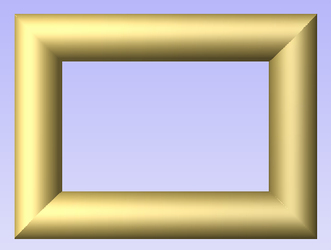

Sweep between spans
When checked ✓ this option will ensure that as the shape is extruded that it goes from a particular span/node in one cross section to the same span/node on the next cross section. For some applications this can give the user more control over the way the shape flows.
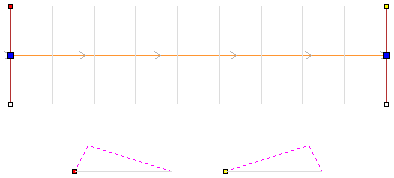
Using the above vector selection, the shape below left will be created with Sweep between spans checked ✓ and the shape on the right is created with the option un-checked. Note that on the left hand picture the crease in the shape goes from node to node in the cross sections as the spans flow exactly from one to the next. On the second picture the shape just linearly flows from one cross section to the next evenly with no additional control.
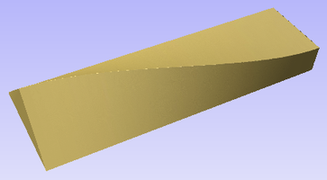
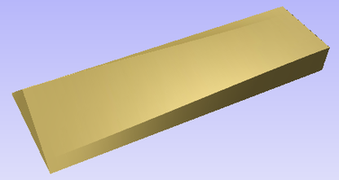
Smooth transition through the Cross Sections
As the extruded shape passes through each cross section the default is for it to flow smoothly through the profile. This can be edited by right-clicking over a cross section and unchecking the Smooth option. The middle node on the cross sections preview in the 2D View will be blue if it is smooth and white if it is un-smooth.
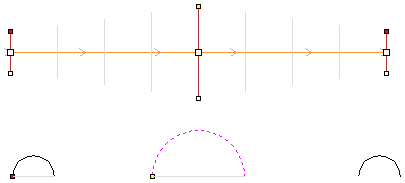
Using the above vector selection, the shape below left will be created with the Smooth option checked ✓ and the shape on the right is created with the option un-checked. Note that on the left hand picture the shape flows smoothly through each span, on the second it goes directly from cross section to cross section in a straight transition.


Extrude and Weave Components
The Extrude and Weave feature also allows the option to use a 3D Component instead of using vector cross sections to define the shape being created. To activate this feature choose the Use a Component option under the Cross Sections / Sweep Interior section of the form.
Once this option has been selected then you need to select a single Component that will be used for the operation. This can only be done within the form and not from either of the views or the Component Tree. Use the arrow at the side of the name in the drop down list to access a list of all the Components and select the one you want to use. By default the first Component name in the Component Tree will be shown in this section of the form. If the form is opened with a single Component selected, the selected Component will be the default in the list. Once selected a preview of the extrusion will be shown in the 2D view.
The orientation of the Component in your part will control how it flows along the vector. The direction along the X-axis of your Component will govern how it flows positively along the drive curve. Another way to think of it is you need to position your Component so it faces from left to right to orient how it will point along the curve.
Once your Component has been selected from the list you need to choose whether it will be used as a single copy stretched along the curve or repeated multiple times at its original size.
Stretch to drive rail length
Picking this option will take a single copy of the Component and stretch it along the full length of the selected drive rail vector.

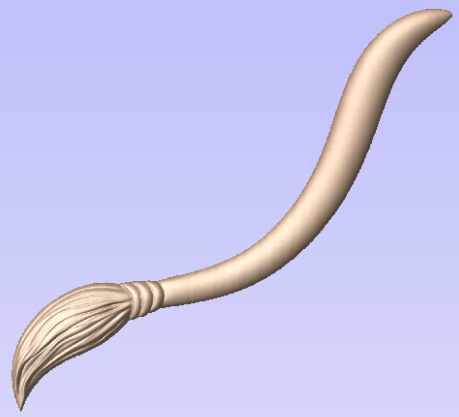
Fill with multiple copies
Selecting this option will keep the Component at its original size and repeat it along the drive curve. Specifying an Overlap value will set each copy of the Component to overlap the previous one by this percentage of its length. Each overlapping piece will be merged together. In addition to overlapping the parts you can also check ✓ a box to flip alternate copies of the Component. This will flip every other copy of the original as if it had been mirrored vertically.
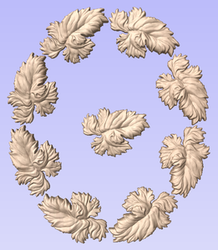
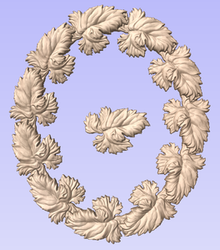
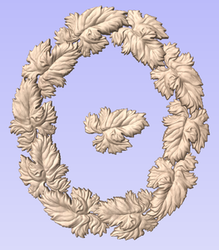
Weave under/over at crossings
With either vector or Component based extrusions you have the option to activate the Weave part of the function. This gives the ability to raise and lower the extruded shape at positions where the drive rail vector or vectors cross over. The effect of this is a Component that appears to be weaving the extruded shapes as you can see below.

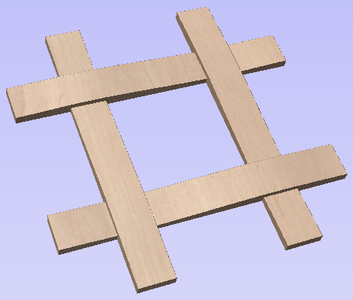
The order of the weave is determined by the direction of the first vector picked as part of the drive-rail selection. To change the order of which overlapping positions are raised up and lowered you can right mouse click on the first drive rail vector you selected and choose the Reverse Rail option.
There are two options to control the way the shape is scaled at each overlapping point in the drive rail vectors, Scale Shape and Add Base.
Scale Shape
The Scale Shape option uses the percentage values entered into the form to scale the height of the original shape up and down at the cross-over positions. For example entering a Z Under percentage of 50% will force the locations which are being weaved under to be half their original height. Entering a Z Over percentage of 150% would force the locations of the shape which are being raised as they weave to be 1 ½ times their original height. This will distort the cross sections or Components to stretch or squash them.
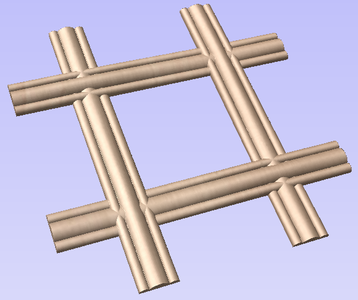

The Scale Shape option will give a natural looking weave but for certain shapes will mean the detail in the shape may become heavily accentuated or reduced at the overlaps. In these situations the Add Base option may create a better result.
Add Base
The Add Base option will retain the height of the original cross section or Component and raise it up adding material under the shape depending on the percentage values indicated. This will typically create a higher final Component than using the Scale Shape option but gives a consistent shape to the strands of the weave.


Scale to Exact Height
Checking ✓ this option scales the shape calculated so its maximum height is the value entered in the Height area of the form.
Common Modeling Options
All of the main modeling tools in the software use a common set of commands to assign a name and combine mode to the component being created along with options to apply the settings in the form, reset the shape, start creating a new component and close to exit the function.
Combine with other components...
This section includes options to allow you to name your Component and control the way it will be combined with other objects in the Component Tree.

Reset
Clicking the Reset button will remove the current shape, doing this before you Close the form will ensure that a component is not created from the current selection. Clicking this does retain the current set of selected vectors or Components.
Apply
Clicking the Apply button will create a shape based on the settings you have chosen. You can continue making edits to the component by choosing different parameters within the form and hitting Apply to update it.
Start New Component
Clicking the Start New Component button will save the state of the component that has been created, deselect all components/vectors and start the creation process again on a new component. The values and options within the form will be retained in this case until you Close it.
Close
Clicking the Close button will close the form returning to the Modeling Tab icons and the updated Component Tree, reflecting any changes that you have made. If you wanted to remove the shape you just created then you can hit the Undo icon or use the keyboard shortcut to undo, CTRL+Z.
Editing vectors while using the Extrude and Weave tool
It is possible to make edits to the vectors that you have selected while using the Extrude and Weave tool. To do this you can click in the whitespace of the 2D View to ensure you have focus on that window. Then on the keyboard hit either N to go into Node Editing mode or T to go into Transform mode.
You will notice the drive rails and cross sections will become deselected and the Use Selection button will change to say Reselect Rails. You can now make edits to the vectors using the dynamic Node Editing and Transform functions in the 2D view. When you are happy with your changes you can click on the Re-select Rails button and the vectors will be selected in the same order they were before. Now you can click the Apply button to create a new shape based on the edited vectors.

